
Original Link: https://www.anandtech.com/show/1567
ATI Radeon X800 XL - A $299 6800GT Competitor
by Anand Lal Shimpi on December 15, 2004 9:00 AM EST- Posted in
- GPUs
A Prelude about Availability
Just two weeks ago, ATI introduced their brand new line of X850 and X800 GPUs, a month before the end of the year. In a highly unusual move for a graphics company to introduce so many new products just before the year's end, many have speculated as to the true reasoning behind ATI's decision. Had this been a launch in October or November, it would have been a non-issue, as that's still (barely) enough time to capitalize on the holiday selling period, but a month before the end of the year?If you ask ATI, the launch was their chance to resolve some availability problems that they had with their higher end cards. ATI promised that within a week of its launch, the Radeon X850 line would be available for purchase online and by January, the new X800 GPUs would also be available. If you ask NVIDIA, they'll say that ATI's year end launch was nothing more than an attempt to delay the purchase of NVIDIA cards and that the availability of the X850 before 2005 was a myth.
If you ask us, we don't know who or what to believe anymore. This past year has been filled of missed releases, missed launches and misinformation. From NVIDIA's Video Processor to ATI's disappearing X700 XT, we're tired of all of it. ATI's promise about X850 GPUs being sold a week after they were launched turned out to be empty as we still can't find any X850 based GPUs available for sale. Even after firing off multiple emails to ATI asking for resolution on the availability matter, we were met with nothing but silence. ATI had no problem answering other questions, but all of our queries about X850 availability have been left untouched. Maybe radio silence will make the problem go away...
We don't think so. The credibility of both GPU vendors has been hurt tremendously this year. Neither side can say that they aren't guilty of the very same things that they accuse the other of doing. It's really a shame because in the end, it hurts their consumers, our readers and makes it much more difficult for anyone, including us, to put faith and trust in what we are told by ATI and NVIDIA.
Hands on with the Radeon X800 XL
Despite all of the issues with availability, about a week ago, ATI fired us off an email saying that we should expect a Radeon X800 XL at our doorsteps. You'll remember from our review of the new X850 and X800 GPUs that the X800 XL is a lower clocked version of the 16-pipe/256-bit memory bus X800 XT built on a 0.11-micron process (as opposed to a 0.13-micron low-k process). Originally priced at $349, the X800 XL would inevitably be ATI's overdue answer to the GeForce 6800GT. We mention its "original" price because less than 24 hours before the publication of this article, ATI informed us that the new price of the X800 XL would be $299, a full $100 less than the GeForce 6800GT. ATI also adjusted the price of the vanilla X800 down to $199.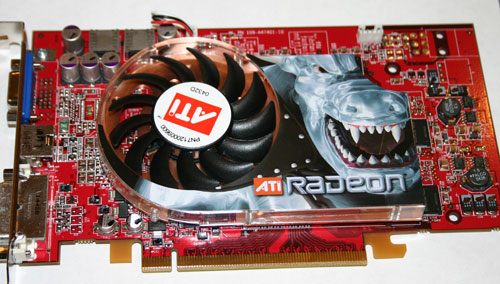
| ATI R480/R430 Product Lineup | |||||||
Corec |
memc |
ppipe |
ddvi |
mem |
fab |
price |
|
| Radeon X850 XT PE | 540 |
1.18 |
16 |
yes |
256 |
0.13 |
$549 |
| Radeon X850 XT | 520 |
1.08 |
16 |
yes |
256 |
0.13 |
$499 |
| Radeon X850 Pro* | 520 |
1.08 |
12 |
no |
256 |
0.13 |
$399 |
| Radeon X800 XL | 400 |
1 |
16 |
no |
256 |
0.11 |
$299 |
| Radeon X800 | 400 |
0.700 |
12 |
no |
128 |
0.11 |
$199 |
The overclocking community was also quite interested in the X800 XL because of its 0.11-micron manufacturing process. While the card comes clocked at 400/500 (core/memory) by default, a 0.11-micron process would mean that it should reach higher clock speeds than the slower, more power consuming 0.13-micron transistors in the X850, right? The problem here is that although the X800 XL's 0.11-micron transistors do consume less power and can switch faster than those in ATI's 0.13-micron GPUs, that doesn't mean that GPUs based on them will run faster. If we were talking about an isolated situation with just one transistor, then there wouldn't be much of an argument, but with the X800 core, we're dealing with around 160 million transistors - greatly complicating things.
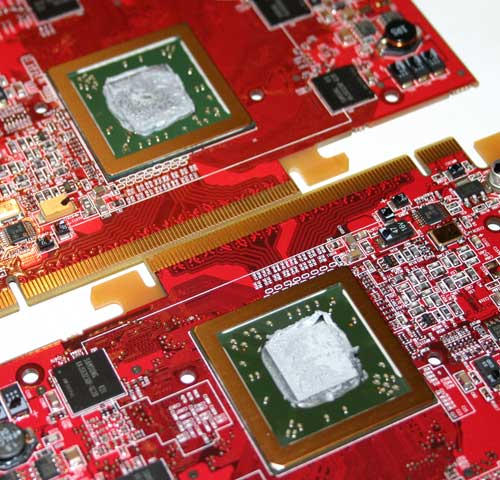
The problem with making smaller transistors running at high frequencies is that there ends up being a great degree of interference or crosstalk between adjacent wires connecting these transistors on the chip. The amount of crosstalk goes up as the operating frequency increases (and as the transistor size decreases), thus becoming a problem as you try and increase the clock of a GPU. The crosstalk is caused by the inherent capacitance of the material surrounding the wires, or put more plainly, the nature of the material next to a wire to remember the charge placed on that wire. So, in order to ramp up clock speed, you have to reduce capacitance and currently, that's done by using materials that have lower "k-values" to insulate between these crosstalking wires. The 0.13-micron process that is used on GPUs like the Radeon X850 XT Platinum Edition is a 0.13-micron process that employs a low-k dielectric just like we mentioned above. The k-value of the dielectric material used in the X850 XT PE is lower than that used in the 0.11-micron X800 XL, making the X850 more resistant to crosstalk. Keeping in mind that the 0.13-micron process is more mature, it's not too surprising that when ATI needed to hit a 540MHz clock speed, they chose their 0.13-micron low-k process and not the 0.11-micron process on which the X800 XL is based.
This isn't to say that the X800 XL won't be a good overclocker, but you shouldn't expect it to be able to hit clock speeds as high as the X850 series. The future is in smaller transistor feature sizes, there's no doubt about that, but for now, the more mature, higher clock speed process is the 0.13-micron low-k process that ATI has used on other members of their product line.
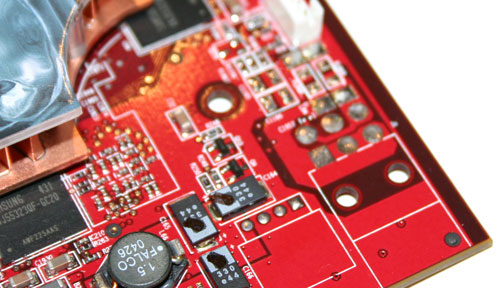
Because of its "low" 400MHz core clock and low power 0.11-micron transistors, the X800 XL gets all the power that it needs from the PCI Express slot with no extra power connector needed.
Unfortunately, we could not test the overclockability of our X800 XL sample as none of the available tools would recognize, much less allow us to adjust the clock speed of the GPU. As soon as the X800 XL is shipping, we should be able to provide you with accurate overclocking expectations of retail cards, which will be much more useful to you than how well our press review sample managed to overclock in the first place. That being said, we would've liked to fulfill our curiosities if it were possible.
So today, we have ATI's first 0.11-micron high end GPU. It won't be able to outrun a X850, even if we could overclock it, but it's priced $100 lower than NVIDIA's 6800GT, which makes it interesting. We've already looked at the performance of the X800 XL in our X850 article, but now we have the ability to focus on power consumption as well as the comparison to NVIDIA's 6800GT in this review. So, let's get to it.
System Level Power Comparison
While it's far from the best way of measuring the power consumption of just the graphics card, with only a handful of days to play around with the X800 XL, our system level power consumption tests are the best option that we have. The tests work like this: we take our testbed, an Athlon 64 FX-55, and measure the power consumption of the entire testbed (RAM, HDD, motherboard, CPU, video card and power supply) at the electrical outlet. What this tells us is the total power consumed by the system, essentially the amount of power for which you're billed. Since we're keeping all other components the same and only swapping out the video card, the impact on power consumption is almost exclusively due to the video card - we say "almost exclusively" because a faster GPU will make the CPU work harder and thus, consume more power and vice versa. But in the end, it's a fairly good indicator of what GPUs consume more power (and thus produce more heat) relative to one another.Our first test has our test bed idling at the Windows desktop at 1600 x 1200. The system specs are as follows:
| System Configuration | |
| Motherboard: | ASUS nForce4 A8N-SLI Deluxe |
| Processor: | AMD Athlon 64 FX-55 |
| RAM: | 1GB Corsair DDR400 |
| Video Drivers: | NVIDIA ForceWare 67.02 Drivers ATI Beta Catalyst Drivers 8.08-041111a-019256E (no Catalyst version has been assigned to this package yet) |
| Operating System(s): | Windows XP Service Pack 2 with DirectX 9.0c |
All performance tests were run at 1600 x 1200, some benchmarks were also run at 1600 x 1200 with 4X AA and 8X AF enabled.
Cool 'n Quiet is disabled, giving us the following breakdown in system power consumption:
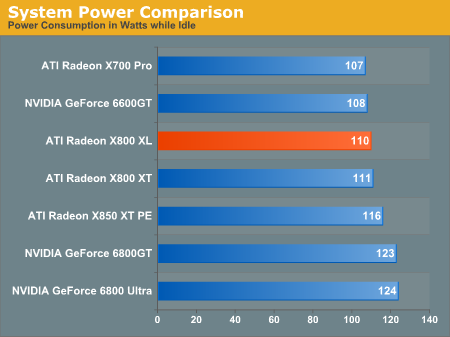
We see that at idle, there's no big improvement to the 0.11-micron process on the X800 XL.
Then we fired up Half Life 2 and ran through our at_prison_05 demo, one of our most stressful GPU tests to see how far we could push power consumption. Here, we see a slight advantage to the X800 XL, but definitely not as dramatic as we would've thought. Given that we're running at a lower core clock, we'd expect the 0.11-micron X800 XL to impact system power consumption more than it did. We would also expect power consumption to decrease as the 0.11-micron process matures and if/when a low-k dielectric is used in conjunction with the smaller transistor feature size.
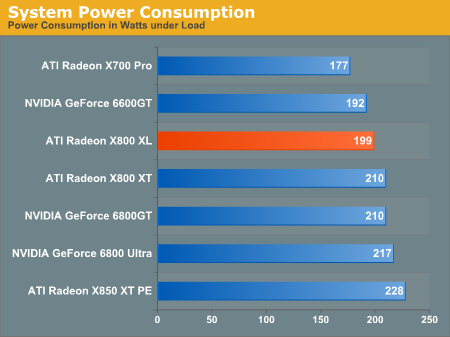
The X800 XL does consume less power and thus, will run cooler than the 6800GT, which is a plus for ATI. Given that the 6800GT is already a single slot solution, the power/heat advantage isn't one that is entirely noticeable considering that the X800 XL cannot be run fanless.
Head to Head: X800 XL vs. 6800GT
The comparison that obviously matters most is the $299 ATI Radeon X800 XL vs. the $399 NVIDIA GeForce 6800GT (the regular 6800 isn't available in a PCI Express version for channel sales yet). The X800 XL will only be available as a PCI Express GPU while the 6800GT is available in both AGP and PCI Express versions. To ATI's credit, however, PCI Express 6800GTs are extremely hard to find while AGP versions are fairly common. In the end, we may just be comparing one unavailable PCI Express card to another, but in a perfect world where availability wasn't an issue, here's how the two would stack up in terms of performance:
You'll first notice that we added a handful of games to our test suite for this comparison - Need for Speed Underground 2, Vampire: The Masquerade - Bloodlines (based on Valve's Source engine), NBA Live 2005 and Sid Meier's Pirates. The reason for expanding the test suite here was to present a broader scope of comparison between the two cards and to avoid only benchmarking games for which ATI/NVIDIA have optimized. Next year, we will have a much more thorough comparison of GPU performance across even more games, but for now, this will have to do.
All of the tests were run at 1600 x 1200, a resolution that both of these cards happen to handle quite well across all games. Our testing yielded the following conclusions:
- Half Life 2 is about 10% faster on the X800 XL than on the 6800GT (based on an average of our 5 demos). However, the other Source engine based game in our suite, Vampire: The Masquerade - Bloodlines, shows the two GPUs performing rather similarly. With only two Source engine based titles, we cannot extrapolate any further based on these results, but they are interesting nonetheless. We will add that although the average frame rates were similar, the minimum frame rates were higher on the X800 XL than on the 6800GT in Vampire. There wasn't a huge difference, but enough to be noticeable during gameplay.
- Under Doom 3, the 6800GT is just under 30% faster than the X800 XL, a huge win for NVIDIA.
- Need for Speed Underground 2 has some serious issues on the 6800GT as it is almost 40% slower than on the X800 XL. While the X800 XL will play NFSU2 quite well at 1600 x 1200 with all of the details turned all the way up (AA off however), the 6800GT cannot. To have a $400 card and not be able to play the latest games at 1600 x 1200 at the highest detail settings is unacceptable in our opinion. This is an area to which NVIDIA needs to pay closer attention.
- Far Cry and Halo both favor the 6800GT with advantages of 12.5% and 10% respectively.
- The five remaining games basically performed identically on the X800 XL and on the 6800GT.
There's the performance comparison that matters, but if you want to see how the X800 XL fits into the grand scheme of things, the next several pages are the same benchmarks that we ran in our X850 review.
Half Life 2 Performance
Click here to download revision 7 updated versions of our Half Life 2 timedemos. Note that these numbers can't be directly compared to numbers generated by the older demos, but they are very close.| Half Life 2 Performance Summary | |||||
| at_canals_08 | at_coast_05 | at_coast_12 | at_prison_05 | at_c17_12 | |
| ATI Radeon X850 XT PE | 116.1 | 134.2 | 111.3 | 114 | 84.6 |
| ATI Radeon X850 XT | 112.6 | 133.6 | 109.4 | 109.6 | 84.4 |
| ATI Radeon X800 XT | 104.9 | 129.2 | 104 | 106.6 | 83 |
| ATI Radeon X800 XL | 92.3 | 121.1 | 97 | 90.8 | 80.2 |
| NVIDIA GeForce 6800 Ultra | 95.6 | 116.4 | 96.4 | 91.6 | 79.7 |
| NVIDIA GeForce 6800GT | 85.5 | 108.8 | 89.3 | 80.3 | 76.2 |
| NVIDIA GeForce 6600GT | 58.3 | 79.4 | 65.1 | 55.8 | 62.1 |
| ATI Radeon X800 | 66.8 | 98.1 | 73.6 | 65.9 | 72.3 |
| ATI Radeon X850 Pro | 91.1 | 118.7 | 93.6 | 87.7 | 80.4 |
| ATI Radeon X800 Pro | 84.1 | 113.1 | 87.7 | 82 | 78.3 |
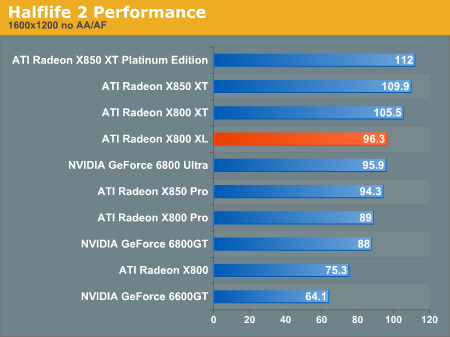
Doom 3 Performance
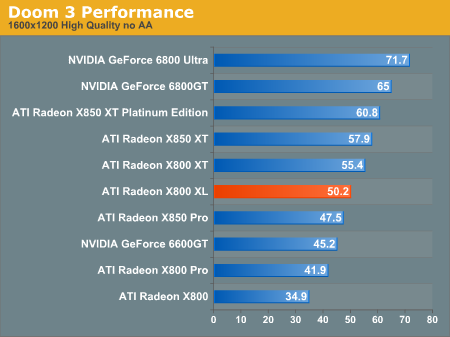
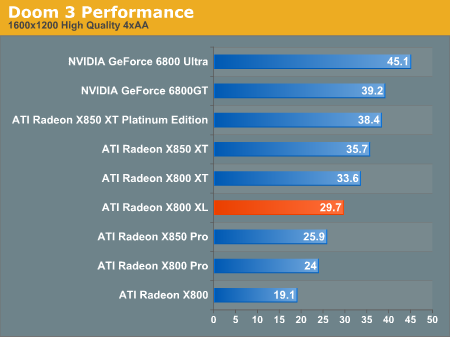
Far Cry Performance
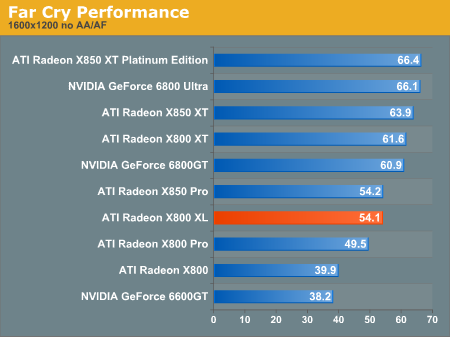
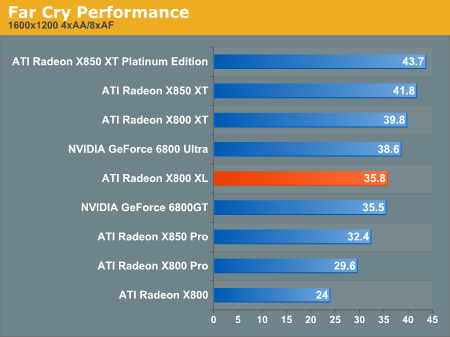
Unreal Tournament 2004 Performance
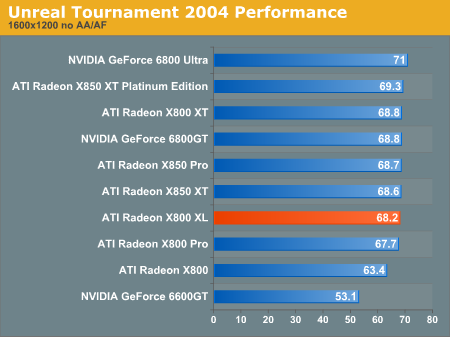
Halo Performance
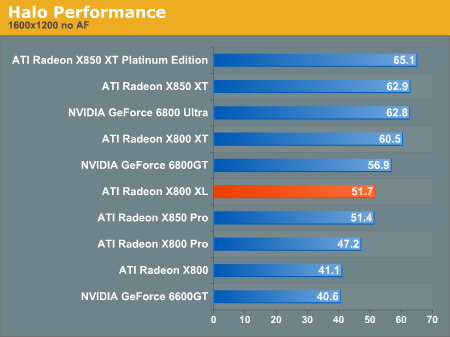
Battlefield: Vietnam Performance
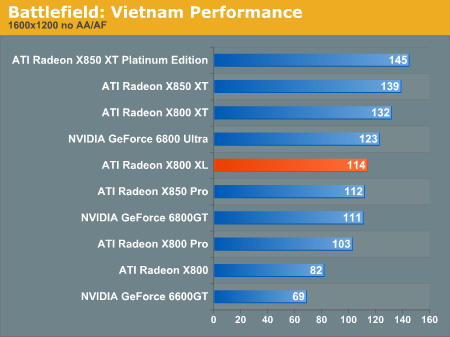
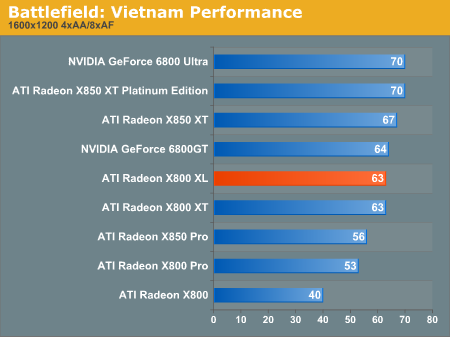
Wolfenstein: Enemy Territory Performance
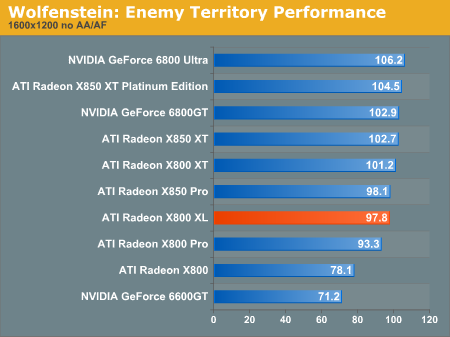
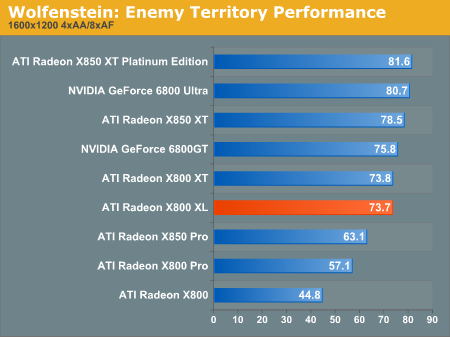
Final Words
As a side note, before we talk about the comparison at hand, at $199, the Radeon X800 does a good job of competing with NVIDIA's GeForce 6600GT. However, it lacks SLI support and isn't available today, so our mid-range recommendation is still firmly planted on the 6600GT if you're buying a card before the end of the year.Once it was launched, we knew that the X800 XL would be an interesting competitor to NVIDIA's GeForce 6800GT, and indeed it is. As we mentioned earlier in the review, ignoring Doom 3, the X800 XL is quite competitive with the 6800GT and should be $100 cheaper when it hits the streets. At a high level, the X800 XL is a more affordable alternative to the 6800GT that offers similar performance in most areas. Unfortunately for ATI, Doom 3 is a big deal and it somewhat complicates our recommendation.
If you are looking for an AGP card, your only option at this price point is really the 6800GT. There are cheaper alternatives, but not better performing AGP alternatives at $400 or less.
ATI informed us at the X850 launch that the X800 XL would be available sometime in January. If this is indeed true, then in January, we'd be foolish not to recommend the X800 XL, not because it offers a huge performance advantage over the 6800GT (which it does not), but because it holds a $100 price advantage over the 6800GT.
If ATI is able to bring out the X800 XL at its suggested street price of $299, then most users won't have a problem glancing over the lower Doom 3 performance, given that the X800 XL is quite competitive in other titles. If ATI can ensure that their only blemish is Doom 3, and should they continue to work hard to reduce that blemish through further driver optimizations, then the X800 XL won't only be the more affordable solution, but it would become the clear solution.
For now, ATI wins because of price, which is something that we're able to live with. Now, if this thing is actually available when it's suppose to be, then we'll be happy. However, if it's not, then ATI will have succeeded in delaying holiday sales of NVIDIA's GeForce 6800GT. If you are at all worried about ATI bringing out the X800 XL on time, then the 6800GT is still a good option, just a potentially more costly one. We can't predict the future, but for the sake of keeping competition cleaner, we're hoping that come January, we won't regret recommending the X800 XL today.







